React生命周期
在组件的整个生命周期中,随着该组件的props或者state发生改变,其DOM表现也会有相应的变化。一个组件就是一个状态机,对于特定地输入,它总返回一致的输出。
组件的生命周期如下
- 实例化
- 存在期
- 销毁期

实例化
1 | var List = React.createClass({ |
其输出结果就是:
1 | getDefaultProps |
- getInitialState 初始化组件的state的值,其返回值会赋值给组件的this.state属性。对于组件的每个实例来说,这个方法的调用次数有且只有一次。与getDefaultProps方法不同的是,每次实例创建时该方法都会被调用一次。
- componentWillMount 此方法会在完成首次渲染之前被调用。这也是在render方法调用前可以修改组件state的最后一次机会。
- render 生成页面需要的虚拟DOM结构,用来表示组件的输出。render方法需要满足:(1)只能通过this.props和this.state访问数据;(2)可以返回null、false或者任何React组件;(3)只能出现一个顶级组件;(4)必需纯净,意味着不能改变组件的状态或者修改DOM的输出。
- componentDidMount 该方法发生在render方法成功调用并且真实的DOM已经被渲染之后,在该函数内部可以通过this.getDOMNode()来获取当前组件的节点。然后就可以像Web开发中的那样操作里面的DOM元素了。
创建阶段
这个阶段只会触发一个getDefaultProps方法,该方法返回一个对象,并且缓存下来。然后与父组件指定的props对象合并,最后赋值给this.props作为该组件的默认属性。对于那些没有被父辈组件指定的props属性的新建实例来说,这个方法返回的对象可用于为实例设置默认的props值。
props属性又是什么呢,它是一个对象,是组件用来接收外面传来的参数的,组件内部是不允许修改自己的props属性的,只能通过父组件来修改。在getDefaultProps方法中,是可以设定props默认值的。
实例化阶段
该阶段主要发生在实例化组件类的时候,也就是该组件类被调用的时候:
1 | ReactDOM.render(<NewView name="ReactJS">children</NewView>, document.body); |
存在期
1 |
|
输出结果为(不包含):
1 | add num |
- componentWillReceiveProps 在任意时刻,组件的props都可以通过父辈组件来更改。当组件接收到新的props(这里不同于state)时,会触发该函数,我们同时也获得更改props对象及更新state的机会。
- shouldComponentUpdate 该方法用来拦截新的props和state,然后开发者可以根据自己设定逻辑,做出要不要更新render的决定,让它更快。
- componentWillUpdate 与componentWillMount方法类似,组件上会接收到新的props或者state渲染之前,调用该方法。但是不可以在该方法中更新state和props。
- render 生成页面需要的虚拟DOM结构,并返回该结构
componentDidUpdate 与componentDidMount类似,更新已经渲染好的DOM。
生命周期之销毁&清理
每当react使用完一个组件,这个组件就必须从DOM中卸载随后被销毁。此时,仅有的一个钩子函数会做出响应,完成所有的清理与销毁工作,这很必要。
componentWillUnmount
最后,随着一个组件从它的层级结构中移除,这个组件的生命也就走到了尽头。该方法会在组件被移出之前调被调用。在componentDidMount方法中添加的所有任务都需要在该方法中撤销,比如说创建的定时器或者添加的事件监听等。

